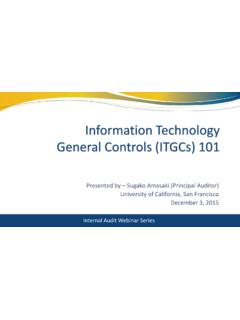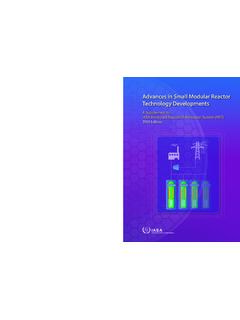Transcription of NASA Technology Taxonomy Lowres
1 National Aeronautics and Space Administration2020 NASAT echnology TaxonomyiThe page intentionally left Letter from the Chief Technologist ..iii Introduction .. vTX01: Propulsion Systems ..1TX02: Flight Computing and Avionics ..15TX03: Aerospace Power and Energy Storage ..27TX04: Robotic Systems .. 35TX05: Communications, Navigation, and Orbital Debris Tracking and Characterization Systems .. 51TX06: Human Health, Life Support, and Habitation Systems .. 65TX07: Exploration Destination Systems ..83TX08: Sensors and Instruments ..95TX09: Entry, Descent, and Landing ..105TX10: Autonomous Systems .. 115TX11: Software, Modeling, Simulation, and Information Processing.
2 127TX12: Materials, Structures, Mechanical Systems, and Manufacturing ..145TX13: Ground, Test, and Surface Systems .. 157TX14: Thermal Management Systems ..173TX15: Flight Vehicle Systems ..185TX16: Air Traffic Management and Range Tracking Systems .. 195TX17: Guidance, Navigation, and Control .. 201 Acronyms ..222 Acknowledgements .. 225iiLetter from the Chief Technologist And as we renew our commitment to lead in space, let s go with confidence and let s go with faith. Faith in the vision and the goal that s articulated today: that we can achieve it; that Americans can achieve anything that we put our minds to.
3 Faith in the extraordinary ingenuity and capability of the men and women of NASA and America s space enterprise, and their ability to meet those challenges if given the resources and the support to do it. And especially faith in the courage of the men and women who are now, and those who will join, the storied ranks of American astronauts that next generation of restless pioneers that will carry American leadership into space. It s extraordinary to think of the heroes that will be forged in our renewed commitment to space. Vice President Michael PenceAs NASA embarks on its renewed commitment to lead in space, we must overcome significant technical challenges to achieve the goal of a sustainable return to the surface of the Moon.
4 We will build on six decades of leadership in space and our work in low-Earth orbit to pave the way to the Moon and on to Mars. The Artemis program will carry the first woman and next man to the Moon, and establish sustainable exploration with our commercial and international partners . NASA is pursuing an ambitious program to explore our solar system and beyond . Key priorities include a Mars Sample Return mission, launch of the James Webb Space Telescope and a robust program of Earth observation . In addition, our transformative aeronautics Technology research is making air travel safer and more efficient, and pioneering the next generation of aircraft. American ingenuity and innovation will be critical to the development of new technologies necessary to achieve NASA s important missions.
5 As NASA undertakes an integrated Technology research and development effort, a common Technology Taxonomy is more important than ever . For this reason, the 2020 NASA Technology Taxonomy was created as an important update to the Technology Area Breakdown Structure (TABS) from the roadmaps of previous years . The 2020 Taxonomy is an update to the 2015 TABS . This new edition builds on previous releases and the insight from subject matter experts from across the Agency . The 2020 Taxonomy has expanded the total number of Technology areas to 17 and consolidated other areas. The update reflects a shift to a structure that aligns Technology areas based on technical disciplines.
6 The updates also include new technologies relevant to NASA, such as cybersecurity and advancements in artificial intelligence. iiiThe Technology Taxonomy is key to NASA s ability to manage and communicate its Technology portfolio by providing a structure for articulating the diverse technologies relevant to NASA s mission. Together, NASA and its partners in other government agencies, international space agencies, academia, and industry, will pave the way to new frontiers in space and aeronautics .Douglas Terrier Chief TechnologistivIntroductionNASA engages in a multitude of Technology development activities to enable NASA missions by broadening knowledge of and capabilities in aeronautics, science, and space.
7 To manage and communicate this extensive and diverse Technology portfolio, NASA uses a Technology Taxonomy . This Taxonomy identifies, organizes, and communicates the Technology areas that NASA advances in order to achieve future space missions and aeronautics activities . The 2020 NASA Technology Taxonomy is an update to the Technology Area Breakdown Structure (TABS) of the 2015 NASA Technology Roadmaps . The TABS, now referred to as the Taxonomy , is deeply ingrained within NASA documentation, TechPort, solicitations, websites, and many other places domestically and internationally . In particular, the Taxonomy provides a structure for articulating NASA s Technology portfolio, which is key to NASA s ability to manage and communicate its Technology development efforts.
8 The 2020 NASA Technology Taxonomy NASA continues to push the boundaries of space missions and aeronautics activities, pursuing challenging goals that require advanced technological capabilities . Progressively ambitious space exploration presents challenges such as sustaining a human presence in space, efficiently navigating to previously inaccessible locations, and communicating over unprecedented distances . For aeronautics, increasing air traffic presents the need for next generation air traffic control; high fidelity, integrated, distributed simulation systems; and next generation vehicles that reduce noise and carbon output . Solutions to these and many other technical challenges require innovative Technology development across many areas, building on proven capabilities as well as developing new ones.
9 The 2020 NASA Technology Taxonomy provides a structure for articulating the Technology development disciplines needed to enable future space missions and support commercial air travel. The Taxonomy identifies, categorizes, and communicates the Technology areas relevant to advancing the Agency s mission. The 2020 revision is comprised of 17 distinct technical discipline based Taxonomies (TXs) that provide a breakdown structure for each Technology area . The Taxonomy uses a three-level hierarchy for grouping and organizing Technology types . Level 1 represents the Technology area, which is the title of that area (e .g . TX01: Propulsion Systems) . Level 2 is a list of the subareas (e.)
10 G . TX01 .1 Chemical Space Propulsion) . Level 3 categorizes the types of technologies within the subareas (e .g . TX1 .1 .1 Integrated Systems and Ancillary Technologies) . Also included is an example technologies section that provides a non-exhaustive sample of relevant technologies .The Taxonomy is a foundational element of NASA s Technology management process. NASA s Mission Directorates (MDs) reference the Taxonomy to solicit Technology proposals and to inform decisions on NASA s Technology policy, prioritization, and strategic investments . These investments are tracked in TechPort, a publically available web-based software system that serves as NASA s integrated Agency Technology data source and decision support tool.














